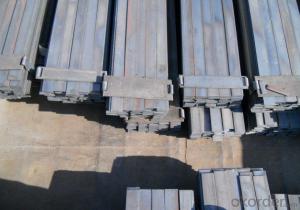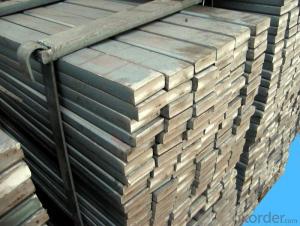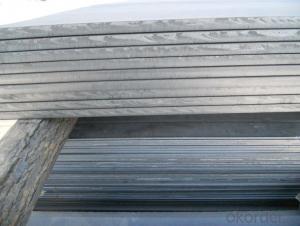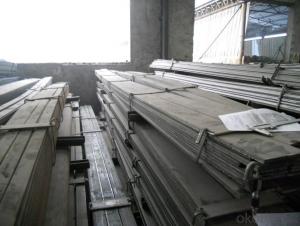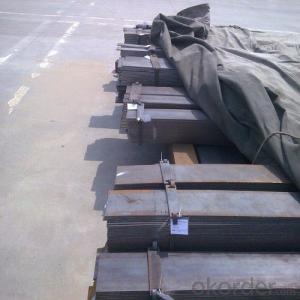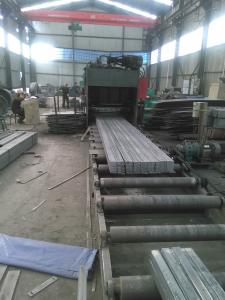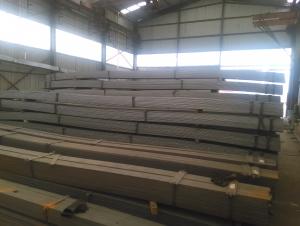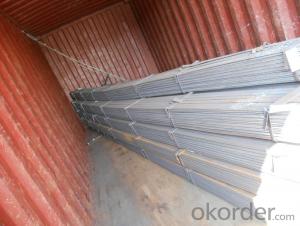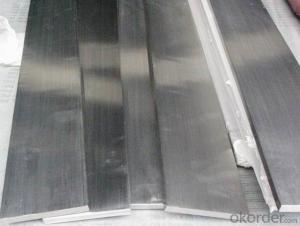Slit Cutting Flat Bar in Material Grade Q235B Steel Flat Bars
- Loading Port:
- Tianjin
- Payment Terms:
- TT or LC
- Min Order Qty:
- 25 m.t
- Supply Capability:
- 10000 m.t/month
OKorder Service Pledge
OKorder Financial Service
You Might Also Like
OKorder is offering high quality Slit Cutting Flat Bar at great prices with worldwide shipping. Our supplier is a world-class manufacturer of steel, with our products utilized the world over. OKorder annually supplies products to European, North American and Asian markets. We provide quotations within 24 hours of receiving an inquiry and guarantee competitive prices.
Product Applications:
Slit Cutting Flat Bars are ideal for structural applications and are widely used in the construction of buildings and bridges, and the manufacturing, petrochemical, and transportation industries.
Product Advantages:
OKorder's Slit Cutting Flats Barare durable, strong, and resist corrosion.
Main Product Features:
· Premium quality
· Prompt delivery & seaworthy packing (30 days after receiving deposit)
· Corrosion resistance
· Can be recycled and reused
· Mill test certification
· Professional Service
· Competitive pricing
Product Specifications:
Manufacture: Slit Cutting
Grade: Q195 – 235
Certificates: ISO, SGS, BV, CIQ
Length: 6m – 12m, as per customer request
Packaging: Export packing, nude packing, bundled
Chemical composition of Q235
Alloy No | Grade | Element(%) | ||||
C | Mn | S | P | Si | ||
Q235 | B | 0.12-0.20 | 0.3-0.7 | ≤0.045 | ≤0.045 | ≤0.3 |
Physical properties of Q235
Alloy No | Grade | Yielding strength point(Mpa) | Tensile strength (Mpa) | Elongation after fracture(%) | ||||||
Thickness (mm) | Thickness (mm) | |||||||||
≤16 | >16--40 | >40--60 | >60--100 | ≤16 | >16--40 | >40--60 | >60--100 | |||
≥ | ≥ | |||||||||
Q235 |
B |
235 |
225 |
215 |
205 |
375--500 |
26 |
25 |
24 |
23 |
Images:
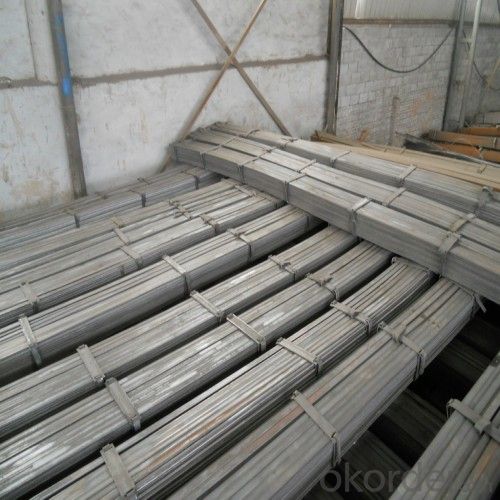
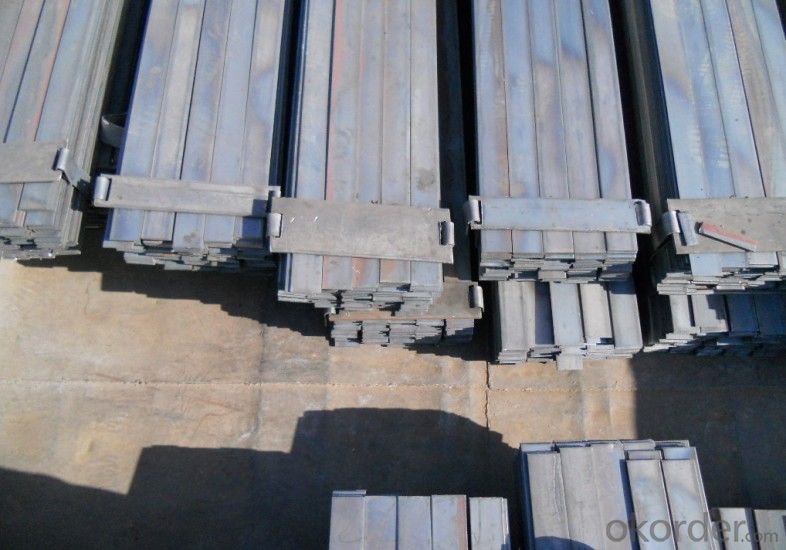
- Q:Are steel flat bars suitable for making storage racks?
- Yes, steel flat bars are suitable for making storage racks. They are strong, durable, and can support heavy loads, making them an ideal choice for storage rack construction. Additionally, steel flat bars can be easily welded or bolted together to create sturdy and customizable storage solutions.
- Q:Can steel flat bars be used in the manufacturing of machinery?
- Yes, steel flat bars can be used in the manufacturing of machinery. Steel flat bars are commonly used in the construction of machinery components due to their strength, durability, and versatility. They can be shaped, cut, and welded to create various machine parts such as brackets, supports, frames, and structural elements. Additionally, steel flat bars offer good resistance to impact, wear, and corrosion, making them suitable for industrial applications in the manufacturing sector.
- Q:Can steel flat bars be used for making furniture frames or supports?
- Yes, steel flat bars can definitely be used for making furniture frames or supports. Steel is a versatile and durable material that offers excellent strength and stability, making it ideal for furniture construction. Steel flat bars provide a strong foundation and structural integrity to furniture frames or supports, ensuring longevity and stability. Additionally, steel can be easily shaped and welded, allowing for flexibility in design and customization. It is commonly used in the construction of various furniture pieces such as tables, chairs, shelving units, and bed frames. Overall, steel flat bars are a reliable choice for furniture frames or supports, providing a sturdy and long-lasting solution.
- Q:Are steel flat bars suitable for architectural metalwork?
- Yes, steel flat bars are suitable for architectural metalwork. They are versatile and commonly used in various architectural applications such as framing, support structures, decorative elements, and trim work. With their strength, durability, and ability to be easily shaped and welded, steel flat bars provide architects and designers with a reliable material option for creating aesthetically pleasing and functional architectural features.
- Q:What is the difference between carbon steel and tool steel flat bars?
- Carbon steel and tool steel flat bars are commonly utilized in a range of industries but have distinct differences. The composition and intended use are the primary factors setting carbon steel apart from tool steel. Carbon steel consists mainly of iron and carbon with small amounts of other elements. It is a versatile and cost-effective material suitable for construction, automotive, and general fabrication purposes. Carbon steel flat bars are known for their durability and strength, making them ideal for structural applications. Conversely, tool steel is a specialized steel type specifically created for crafting tools and dies. It contains additional alloying elements like chromium, vanadium, tungsten, or molybdenum, which enhance hardness, wear resistance, and toughness. Tool steel flat bars maintain their shape and cutting edge even under high temperatures and intensive use. They are commonly employed in the manufacturing of precision components, tools, dies, and molds. Another contrast between carbon steel and tool steel flat bars lies in their hardness. Tool steel flat bars are generally much harder than carbon steel flat bars due to their higher alloy content. This increased hardness enables tool steel to endure the repetitive stress and impact often encountered during tooling operations. In terms of cost, carbon steel flat bars are generally more affordable than tool steel flat bars. This is because tool steel necessitates additional alloying elements to attain the desired properties, which raises production costs. In conclusion, although carbon steel and tool steel flat bars share the commonality of being types of steel, they serve different purposes. Carbon steel is a versatile and economical material used in various applications, while tool steel is a specialized steel designed for tool and die production. Tool steel flat bars are harder and more expensive due to their alloy content, while carbon steel flat bars are renowned for their strength and affordability.
- Q:How do steel flat bars compare to wood for certain applications?
- Certain applications benefit from the use of steel flat bars instead of wood for several reasons. Firstly, steel is significantly stronger and more durable than wood, making it ideal for heavy-duty applications where strength is of utmost importance. Steel flat bars can withstand higher loads and pressures compared to wooden bars, making them suitable for providing structural support in construction projects. Moreover, steel flat bars do not succumb to issues such as rot, decay, or pest infestations, which are prevalent in wood. This renders steel a more reliable and long-lasting material, especially in outdoor or moist environments. Additionally, steel is fire-resistant, unlike wood, which can be a critical consideration in applications where fire safety is a concern. Another advantage of steel flat bars lies in their consistent and uniform dimensions. Unlike wood, which can vary in size and shape due to natural defects, steel flat bars are precisely manufactured and maintain consistent dimensions throughout. This facilitates ease of use and ensures accurate and precise fittings in construction or fabrication applications. Furthermore, steel flat bars are easily recyclable, contributing to a more sustainable choice compared to wood. Steel is highly recyclable, and opting for steel flat bars over wood aids in reducing deforestation and minimizing environmental impact. Nevertheless, it is important to acknowledge that wood also possesses advantages in certain applications. Wood is a natural material that imparts a warm and visually appealing appearance, which may be desirable in architectural or interior design projects. Additionally, wood can be more manageable and offer greater flexibility in terms of shaping or customization. In conclusion, steel flat bars surpass wood in terms of strength, durability, resistance to rot and pests, fire safety, and dimensional consistency. However, the selection between steel and wood ultimately hinges on the specific requirements and aesthetics of the given application.
- Q:What's the difference between hot rolled flat steel and flat rolling tool flat steel?
- Hot rolled flat rolled hot rolled flat steel is a general purpose rectangular cross rolled strip. The specifications are expressed in millimeters of thickness * width, flat steel can be finished steel, used for components, ladders, bridges and fences, etc..
- Q:Can steel flat bars be hardened or tempered?
- Steel flat bars can indeed undergo hardening or tempering. Hardening entails heating the steel to a specific temperature and rapidly cooling it, typically through water or oil quenching. This procedure alters the steel's molecular structure, resulting in heightened hardness and resistance against wear and deformation. Conversely, tempering takes place after hardening and involves reheating the steel to a lower temperature, followed by slow cooling. This step aids in alleviating internal stresses and enhancing the steel's toughness and ductility, rendering it less brittle and more suitable for certain applications. To achieve desired mechanical properties, both hardening and tempering can be employed on steel flat bars. It is important to note, however, that the particular hardening or tempering method and parameters may differ depending on the type of steel utilized and the desired outcome.
- Q:How do steel flat bars compare to stainless steel flat bars?
- Steel flat bars and stainless steel flat bars differ in their composition and properties. Steel flat bars are typically made from carbon steel, which provides strength and durability but is susceptible to rust and corrosion. On the other hand, stainless steel flat bars are made from an alloy that contains chromium, which offers excellent corrosion resistance. Stainless steel flat bars are also known for their aesthetic appeal and are commonly used in applications where hygiene and appearance are important, such as in the food industry or architectural projects. Overall, stainless steel flat bars are a superior option in terms of corrosion resistance, while steel flat bars are more affordable and suitable for applications where corrosion resistance is not a primary concern.
- Q:What are the different grades of steel used in flat bars?
- Flat bars commonly use several grades of steel, each with unique properties and applications. Some of the most frequently used grades are: 1. Mild Steel (or low carbon steel): This grade is widely utilized in flat bars due to its low carbon content, making it easy to work with and weldable. It finds applications in construction, automotive, and general fabrication. 2. Carbon Steel: With a higher carbon content (usually ranging from 0.30% to 2.0%), carbon steel offers increased strength and hardness compared to mild steel. It is suitable for applications requiring higher load-bearing capabilities, such as machinery parts and structural components. 3. Alloy Steel: This type of steel contains additional elements like manganese, silicon, nickel, chromium, or molybdenum, which enhance mechanical properties such as strength, hardness, and corrosion resistance. Alloy steel flat bars are commonly used in manufacturing tools, gears, and machine parts. 4. Stainless Steel: Stainless steel is corrosion-resistant and contains a minimum of 10.5% chromium. It excels in environments prone to rust, staining, and corrosion, making it ideal for applications in food processing, pharmaceuticals, and marine industries. Stainless steel flat bars come in various grades, with 304 and 316 being the most common. 5. Tool Steel: Designed to exhibit exceptional hardness, toughness, and wear resistance, tool steel is specialized for manufacturing cutting tools, molds, and dies. Tool steel flat bars are available in grades like A2, D2, and O1, each offering specific properties for different applications. These examples represent only a few of the many specialized grades available for flat bars, including heat-resistant steel, wear-resistant steel, and high-strength steel. The choice of grade depends on specific application requirements, such as strength, corrosion resistance, hardness, and other properties.
1. Manufacturer Overview |
|
|---|---|
| Location | |
| Year Established | |
| Annual Output Value | |
| Main Markets | |
| Company Certifications | |
2. Manufacturer Certificates |
|
|---|---|
| a) Certification Name | |
| Range | |
| Reference | |
| Validity Period | |
3. Manufacturer Capability |
|
|---|---|
| a)Trade Capacity | |
| Nearest Port | |
| Export Percentage | |
| No.of Employees in Trade Department | |
| Language Spoken: | |
| b)Factory Information | |
| Factory Size: | |
| No. of Production Lines | |
| Contract Manufacturing | |
| Product Price Range | |
Send your message to us
Slit Cutting Flat Bar in Material Grade Q235B Steel Flat Bars
- Loading Port:
- Tianjin
- Payment Terms:
- TT or LC
- Min Order Qty:
- 25 m.t
- Supply Capability:
- 10000 m.t/month
OKorder Service Pledge
OKorder Financial Service
Similar products
New products
Hot products
Hot Searches
Related keywords

